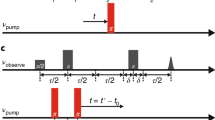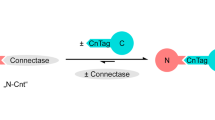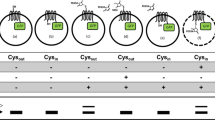Abstract
Cysteine is an extremely useful site for selective attachment of labels to proteins for many applications, including the study of protein structure in solution by electron paramagnetic resonance (EPR), fluorescence spectroscopy and medical imaging. The demand for quantitative data for these applications means that it is important to determine the extent of the cysteine labeling. The efficiency of labeling is sensitive to the 3D context of cysteine within the protein. Where the label or modification is not directly measurable by optical or magnetic spectroscopy, for example, in cysteine modification to dehydroalanine, assessing labeling efficiency is difficult. We describe a simple assay for determining the efficiency of modification of cysteine residues, which is based on an approach previously used to determine membrane protein stability. The assay involves a reaction between the thermally unfolded protein and a thiol-specific coumarin fluorophore that is only fluorescent upon conjugation with thiols. Monitoring fluorescence during thermal denaturation of the protein in the presence of the dye identifies the temperature at which the maximum fluorescence occurs; this temperature differs among proteins. Comparison of the fluorescence intensity at the identified temperature between modified, unmodified (positive control) and cysteine-less protein (negative control) allows for the quantification of free cysteine. We have quantified both site-directed spin labeling and dehydroalanine formation. The method relies on a commonly available fluorescence 96-well plate reader, which rapidly screens numerous samples within 1.5 h and uses <100 μg of material. The approach is robust for both soluble and detergent-solubilized membrane proteins.
This is a preview of subscription content, access via your institution
Access options
Subscribe to this journal
Receive 12 print issues and online access
$259.00 per year
only $21.58 per issue
Buy this article
- Purchase on Springer Link
- Instant access to full article PDF
Prices may be subject to local taxes which are calculated during checkout



Similar content being viewed by others
References
Hoff, A.J. Advanced EPR. Applications in Biology and Biochemistry (Elsevier, 1989).
Powl, A.M., Wright, J.N., East, J.M. & Lee, A.G. Identification of the hydrophobic thickness of a membrane protein using fluorescence spectroscopy: studies with the mechanosensitive channel MscL. Biochemistry 44, 5713–5721 (2005).
Hubbell, W.L., Cafiso, D.S. & Altenbach, C. Identifying conformational changes with site-directed spin labeling. Nat. Struct. Biol. 7, 735–739 (2000).
Chalker, J.M., Bernardes, G.J.L., Lin, Y.A. & Davis, B.G. Chemical modification of proteins at cysteine: opportunities in chemistry and biology. Chem. Asian J. 4, 630–640 (2009).
Ellman, G.L. Tissue sulfhydryl groups. Arch. Biochem. Biophys. 82, 70–77 (1959).
Lu, J. & Deutsch, C. Pegylation: a method for assessing topological accessibilities in Kv1.3. Biochemistry 40, 13288–13301 (2001).
Endeward, B., Butterwick, J.A., MacKinnon, R. & Prisner, T.F. Pulsed electron-electron double-resonance determination of spin-label distances and orientations on the tetrameric potassium ion channel KcsA. J. Am. Chem. Soc. 131, 15246–15250 (2009).
Riener, C.K., Kada, G. & Gruber, H.J. Quick measurement of protein sulfhydryls with Ellman's reagent and with 4,4′-dithiodipyridine. Anal. Bioanal. Chem. 373, 266–276 (2002).
Mansfeld, J. et al. Extreme stabilization of a thermolysin-like protease by an engineered disulfide bond. J. Biol. Chem. 272, 11152–11156 (1997).
Rasmussen, T. et al. Tryptophan in the pore of the mechanosensitive channel MscS. J. Biol. Chem. 285, 5377–5384 (2010).
Ericsson, U.B., Hallberg, B.M., Detitta, G.T., Dekker, N. & Nordlund, P. Thermofluor-based high-throughput stability optimization of proteins for structural studies. Anal. Biochem. 357, 289–298 (2006).
Alexandrov, A.I., Mileni, M., Chien, E.Y.T., Hanson, M.A. & Stevens, R.C. Microscale fluorescent thermal stability assay for membrane proteins. Structure 16, 351–359 (2008).
Mansoor, S.E., Mchaourab, H.S. & Farrens, D.L. Determination of protein secondary structure and solvent accessibility using site-directed fluorescence labeling. studies of T4 lysozyme using the fluorescent probe monobromobimane. Biochemistry 38, 16383–16393 (1999).
Liu, W., Hanson, M.A., Stevens, R.C. & Cherezov, V. LCP-Tm: an assay to measure and understand stability of membrane proteins in a membrane environment. Biophys. J. 98, 1539–1548 (2010).
Sippel, T.O. New fluorochromes for thiols: maleimide and iodoacetamide derivatives of a 3-phenylcoumarin fluorophore. J. Histochem. Cytochem. 29, 314–316 (1981).
Chalker, J.M., Lercher, L., Rose, N.R., Schofield, C.J. & Davis, B.G. Conversion of cysteine into dehydroalanine enables access to synthetic histones bearing diverse post-translational modifications. Angew. Chem. 51, 1835–1839 (2012).
Pliotas, C. et al. Conformational state of the MscS mechanosensitive channel in solution revealed by pulsed electron–electron double resonance (PELDOR) spectroscopy. Proc. Natl. Acad. Sci. USA 109, 2675–2682 (2012).
Hagelueken, G. et al. PELDOR spectroscopy distance fingerprinting of the octameric outer-membrane protein Wza from Escherichia coli. Angew. Chem. 48, 2904–2906 (2009).
Bode, B.E. et al. Counting the monomers in nanometer-sized oligomers by pulsed electron-electron double resonance. J. Am. Chem. Soc. 129, 6736–6745 (2007).
Borbat, P.P. & Freed, J.H. Measuring distances by pulsed dipolar ESR spectroscopy: spin-labeled histidine kinases. Methods Enzymol. 423, 52–116 (2007).
Bordignon, E. Site-directed spin labeling of membrane proteins. Top. Curr. Chem. 321, 121–157 (2012).
Schiemann, O. & Prisner, T.F. Long-range distance determinations in biomacromolecules by EPR spectroscopy. Q. Rev. Biophys. 40, 1–53 (2007).
Chalker, J.M. et al. Methods for converting cysteine to dehydroalanine on peptides and proteins. Chem. Sci. 2, 1666–1676 (2011).
Aebersold, R. & Mann, M. Mass spectrometry-based proteomics. Nature 422, 198–207 (2003).
White, G.F. et al. Subunit organization in the TatA complex of the twin arginine protein translocase: a site-directed EPR spin labeling study. J. Biol. Chem. 285, 2294–2301 (2010).
Stoll, S. et al. Double electron-electron resonance shows cytochrome P450cam undergoes a conformational change in solution upon binding substrate. Proc. Natl. Acad. Sci. USA 109, 12888–12893 (2012).
Vasquez, V., Cortes, M.D., Furukawa, H. & Perozo, E. An optimized purification and reconstitution method for the MscS channel: strategies for spectroscopical analysis. Biochemistry 46, 6766–6773 (2007).
Plechanovová, A. et al. Mechanism of ubiquitylation by dimeric RING ligase RNF4. Nat. Struct. Mol. Biol. 18, 1052–1060 (2011).
Acknowledgements
We acknowledge the Biomedical Sciences Research Complex Mass Spectrometry and Proteomics Facility for mass spectroscopy analysis and assistance with writing the manuscript; B. Bode and R. Ward for discussing the manuscript; A. Plechanovová at the University of Dundee for providing the plasmid for UbcH5a; and J. Chalker at the University of Oxford for providing the dibromide reagent. The UK Biotechnology and Biological Sciences Research Council (BB/H017917/1), the Wellcome Trust (WT081862) and EaStCHEM (E.B. studentship) funded this work.
Author information
Authors and Affiliations
Contributions
E.B., C.P. and G.H. performed experiments. E.B., C.P., G.H. and J.H.N. analyzed the data. E.B., C.P. and J.H.N. wrote the paper.
Corresponding author
Ethics declarations
Competing interests
The authors declare no competing financial interests.
Integrated supplementary information
Supplementary Figure 1 cwEPR spectra for spin-labeled MscS mutants.
cwEPR spectra for MscS (a) V32R1 (b) S58R1, (c) D67R1, (d) L124R1 and (e) S147R1 and the positive control (f) 4-amino TEMPO with magnetic field (x axis) plotted against intensity (y axis) for each mutant.
Supplementary Figure 2 Thermofluor profile at low concentration.
Thermofluor profile for MscS S147R1 showing the negative control in blue, the positive control in red and the spin-labeled sample in green. Repeat measurements are denoted with (1) a smooth line and (2) a dashed line. The temperature at which the fluorescence intensity was used is highlighted with a black line.
Supplementary information
Supplementary Methods
Double integration of cwEPR spectra and mass spectroscopy. (PDF 53 kb)
Supplementary Table 1
Efficiency of conversion of cysteine. Table of data presented in Figure 3a showing the percentage of spin-labeling efficiency and the conversion to dehydroalanine calculated using the fluorescence assay and cwEPR (where appropriate), including associated error estimations. (PDF 74 kb)
Supplementary Figure 1
cwEPR Spectra for Spin Labeled MscS Mutants. (PDF 178 kb)
Supplementary Figure 2
Thermofluor Profile at Low Concentration. (PDF 2108 kb)
Rights and permissions
About this article
Cite this article
Branigan, E., Pliotas, C., Hagelueken, G. et al. Quantification of free cysteines in membrane and soluble proteins using a fluorescent dye and thermal unfolding. Nat Protoc 8, 2090–2097 (2013). https://doi.org/10.1038/nprot.2013.128
Published:
Issue Date:
DOI: https://doi.org/10.1038/nprot.2013.128
This article is cited by
-
Allosteric activation of an ion channel triggered by modification of mechanosensitive nano-pockets
Nature Communications (2019)
-
The role of lipids in mechanosensation
Nature Structural & Molecular Biology (2015)
Comments
By submitting a comment you agree to abide by our Terms and Community Guidelines. If you find something abusive or that does not comply with our terms or guidelines please flag it as inappropriate.



